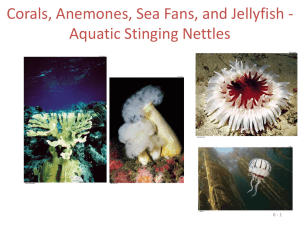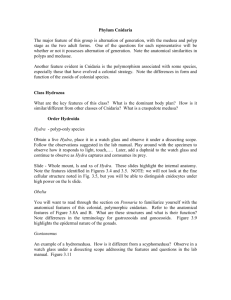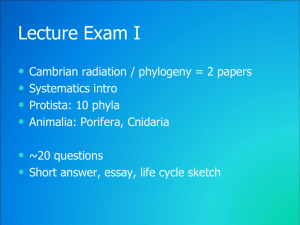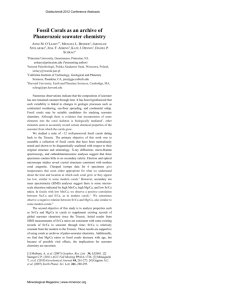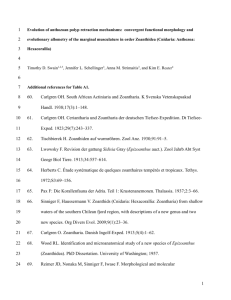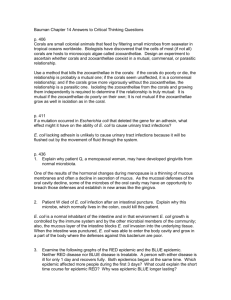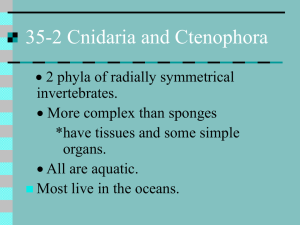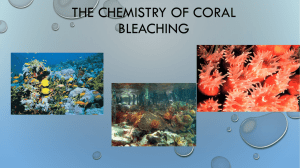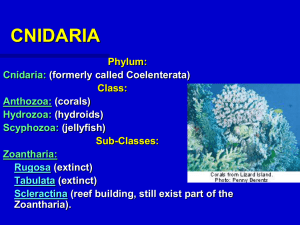ppt
advertisement
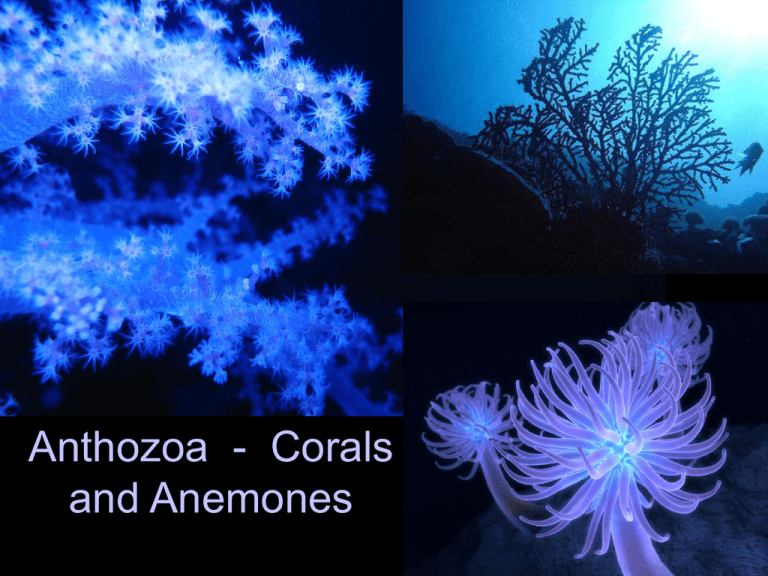
Anthozoa - Corals and Anemones Anemones Corals Corals Anthozoa • Sea anemones and most corals • Polyp is dominant and only life form – NO MEDUSA – Presents evolutionary question: • Were the original cnidarians all medusae and pelagic, with the medusa being lost in the anthozoans and most hydrozoans? • OR is the polyp and a benthic existence the primitive state with the pelagic medusa evolving later? Anthozoa • Reproduction – Asexual • Longitudinal or transverse fission • Pedal laceration – Parts of pedal disk detach and differentiate into new animal – Sexual • Gametes produced by polyp • Planula larvae produce another polyp Anthozoa • Defense and territoriality – Acrorhagi: special stinging cells used to defend territory against neighboring anemones – Also have capture tentacles – Sweeper tentacles in corals and some anemones acrorhagi Feeding tentacles Sweeper Tentacles Sweeper Tentacles Sweeper Tentacles Anthozoa • Feeding – Carnivorous • Use nematocysts on tentacles – Anatomy differs from hydrozoan polyps • Food enters mouth and then goes through tubular pharynx before entering the gastrovascular cavity • Ciliated grooves called siphonoglyphs extend down the pharynx from the mouth • Gastrovascular cavity is partitioned by mesenteries – Infoldings of gastrodermis – Increases surface area for secreting digestive enzymes and for nutrient absorption siphonoglyph gonads Anthozoa • Muscles and movement – Longitudinal and circular muscles – Sea water in gastrovascular cavity acts as hydrostatic skeleton – Some anemones can “crawl” slowly – Others are carried around by other invertebrates – A few can swim – Most are sessile Sea Anemones • Symbioses – Zooxanthellae • “Anemone fish” – Percula clown fish in aquarium – These fish have substituted the mushroom corals for sea anemones • Anemones are too dangerous in a reef tank • They will sting other corals and kill many of the hard and soft corals and polyps Corals and Coral Reefs • Types of corals – Subclass Hexacorallia • Tentacles in multiples of 6 around mouth • Solitary forms are the sea anemones • No special protective covering • Colonial species are the true or “stony” corals • Found in warm, clear water • Largest reefs are found in tropical areas of the Indo-Pacific • One of the largest reefs is the Great Barrier Reef off the northeast coast of Australia – 2000 km long – 145 km wide Sublcass Hexacorallia (=Zoantharia) • True anemones: Order Actiniaria • Mushroom corals: Order Corallimorpharia • Zoanthis polyps: Order Zoanthidea • True corals: Order Scleractinia Order Actiniaria Order Corallimorpharia Order Corallimorpharia Order Zoanthidea Order Zoanthidea Hexacorallia • Corals are carnivorous but usually occur where plankton is not abundant – Coral polyps have zooxanthellae • Endosymbiotic dinoflagellates • Require high amounts of light for photosynthesis • Therefore silty deposits from land can suffocate a reef • Zooxanthellae are very sensitive to heat so global warming is another danger for reefs as sea temperatures rise • Zooxanthellae provide photosynthate to coral polyp and use the metabolic wastes from the animal for its own growth Zooxanthellae in Xenia Hexacorallia • Formation of coral skeleton – Rate of reef growth is higher in light than in dark • Therefore: implies zooxanthellae play a role – Mechanism? • Have an effect on availability of bicarbonate ion which is essential for calcification process • Contribute some critical component of the organic matrix that allows for calcium carbonate deposits to form • Localized removal of dissolved phosphates (nutrient for algae) which can inhibit formation of calcium carbonate • Generate extra oxygen through photosynthesis which speeds up rate of coral metabolism Hexacorallia • Subclass Octocorallia (Alcyonaria) – 8 tentacles – Tentacles are pinnate – Some have no support other than the thick mesoglea • These are the soft corals – Others have proteinaceous or calcareous internal skeletons • These are the gorgonians and pipe corals Subclass Octocorallia (AKA Alcyonaria) • Xenia – pulse corals • Sea Pens • Gorgonians – see lab samples Miscellany • Corals have medical uses – Tiny pieces of coral are used for some bone grafts especially face and jaw • Tiny pores are rapidly infiltrated by capillaries and bone forming osteoblasts – Used to make artificial eyes move! • Blood vessels and muscles invade coral fragment and then patient can use their own muscles to move the fake eyeball Emerging Patterns in Evolution • Skeleton (Hydrostatic Skeleton) • Contractile tissues/locomotion • Nervous system • Gut • Gastrulation • Radial Symmetry • Two embryonic tissues 3 Germ Layers Ectoderm forms epidermis and central nervous system Endoderm forms the lining of gut and associated organs – It is argued that the early embryo may have more than just these two • Mesoderm forms all the stuff in between gut tube and skin, such as, muscle, bone, connective tissue, blood, etc. The Cnidaria are good candidates as the crossroad of metazoan evolution. • Sponges are the living proof of how a protozoan colony can become a metazoan, without reaching a level of organisation involving a recognisable body form, real tissues and a nervous system. • The Cnidaria are the first animals with tissue layers, muscles, and sense organs. – They lie at the base of the tree because they are diploblastic, have radial symmetry, and do not have a real brain. Cnidaria and Metazoan Evolution • They are present in the fossil record since the Precambrian, when animals similar to modern forms were absent. • The strange creatures of the Precambrian, besides cnidarians, apparently did not pose the foundations of future metazoan organisations, whereas these are evident in the Cnidaria. • Boero, Bouillon, and Piraino. 2005. The role of Cnidaria in evolution and ecology. It. J. Zool. 72:65-71 Cnidaria and Metazoan Evolution • From an ecological point of view, the cnidarians probably play roles that are much more important than usually perceived. – Both Cnidaria and Ctenophora feed on the eggs and larvae of most benthic, planktonic and nektonic organisms • Might be keystone species • Maintain high biodiversity, by feeding on potentially highly competitive, resource monopolizing species. • During periodic outbreaks of their populations – serious effects on fisheries yields and other problems Myxozoa Myxozoa Phylogenomic Analyses Firmly Place Myxozoa in Cnidaria • All Myxozoa possess polar capsules that are similar to nematocysts of Cnidaria in ultrastructure and ontogeny and are used for host attachment • Presence of a minicollagen gene – Minicollagens are cnidarian-specific constituents of nematocyst walls. • Phylogenetic analyses placed Myxozoa as sister group of Medusozoa within Cnidaria Maximilian P. Nesnidal, Martin Helmkampf, Iris Bruchhaus, Mansour El-Matbouli, B. Hausdorf. Agent of Whirling Disease Meets Orphan Worm: Phylogenomic Analyses Firmly Place Myxozoa in Cnidaria. PLOS One Published: January 30, 2013 DOI: 10.1371/journal.pone.0054576 Phylogenetic tree based on a dataset including 128 genes Myxozoa • Myxozoa ("slime animals") are so unusual that they were long believed to be protozoa entirely the wrong kingdom - until molecular analysis proved a direct relationship with the jellyfish, corals and other cnidaria. It's an understandable mistake, considering these "jellies" can consist of as little as a single cell and live as parasites in other animals; jellies who evolved into germs. Myxozoa • Most slime animals pass through two different hosts in their life cycle. Actinospores Myxospores Myxozoa – Actinospores • Work the same way but attack larger hosts; • Most species attack fish, but a few are known to favor amphibians or aquatic reptiles, and at least one invades shrews. • In larger hosts, the plasmodium can become visible to the naked eye, a concentration of thick, clear slime growing and feeding in the host's tissues. • Some attack the muscles, some attack the heart, some even dwell within the spinal column, causing severe skeletal deformities and neurological damage. • Thousands of spores are released once the host dies, with some species killing more than 90% of infected fish. The newly-discovered parasite which creates mysterious holes in the Greenland halibut was discovered by Greenlandic fishermen, and researchers have yet to figure out how prevalent this parasite is. (April 7, 2012)
